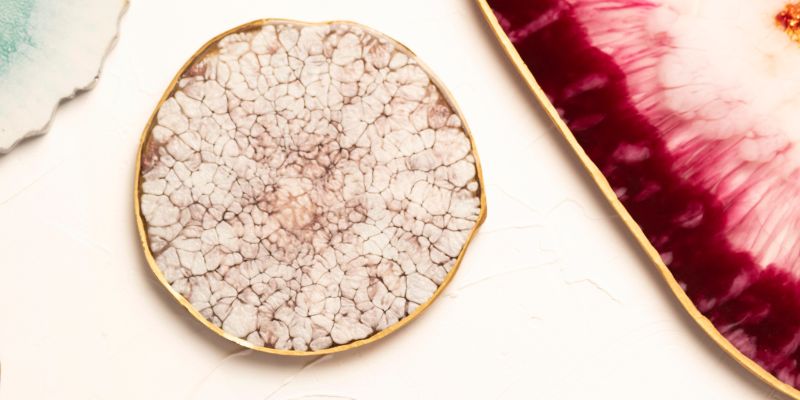Introduction: Resin art has taken the crafting and art world by storm, captivating artists and enthusiasts with its mesmerizing beauty and endless possibilities. The glossy finish, vibrant colors, and unique textures make resin art a truly captivating form of self-expression. In this blog post, we will delve into the secrets of resin art, exploring the materials, techniques, and tips to help you unlock your creativity and create stunning resin masterpieces.
-
Understanding Resin: Resin is a versatile material that, when combined with a hardener, undergoes a chemical reaction to form a solid, glossy finish. There are two main types of resin used in art: epoxy resin and polyester resin. Epoxy resin is widely preferred due to its clarity, UV resistance, and ease of use. Polyester resin, on the other hand, is popular for its affordability but may yellow over time.
-
Materials Needed: To embark on your resin art journey, you will need a few essential materials:
- Epoxy resin or polyester resin
- Hardener
- Mixing cups and sticks
- Pigments or dyes for coloration
- A torch or heat gun to remove air bubbles
- A silicone mold or canvas for pouring the resin
- Protective gear such as gloves and goggles
-
Preparing the Workspace: Resin art requires a clean and well-ventilated workspace. Ensure that your working surface is level and protected with plastic or a non-stick mat. It's also advisable to cover nearby surfaces with plastic sheets to prevent any accidental spills or drips.
-
Mixing and Pouring: Resin Title: Unlocking the Secrets of Resin Art: A Guide to Creating Stunning Masterpieces
Introduction: Resin art has taken the art world by storm in recent years, captivating artists and enthusiasts alike with its mesmerizing beauty and endless creative possibilities. This unique medium allows artists to create stunning masterpieces that are both visually striking and tactile. In this blog post, we will delve into the secrets of resin art, exploring its techniques, tools, and tips to help you unlock your artistic potential.
Understanding Resin: Resin, in its simplest form, is a liquid material that hardens into a clear, glossy finish when cured. It is commonly made from a two-part mixture of epoxy resin and a hardener. The hardener initiates a chemical reaction, causing the resin to solidify and become durable. This transformation is what allows artists to create captivating and long-lasting resin art pieces.
Materials and Tools: To embark on your resin art journey, you will need a few essential materials and tools. These include:
-
Epoxy Resin: Choose a high-quality epoxy resin that is specifically formulated for art purposes. Ensure that the resin is non-toxic and provides a crystal-clear finish.
-
Hardener: The hardener is the catalyst that initiates the curing process. It is essential to mix the resin and hardener in the correct ratio, as specified by the manufacturer, to ensure optimal results.
-
Pigments and Dyes: Explore the vibrant world of resin art by adding pigments and dyes to your resin mixture. These colorants allow you to create captivating designs and striking color combinations.
-
Mixing Tools: Use a clean plastic or silicone mixing cup and stir sticks to mix the resin and hardener thoroughly. Avoid using wooden stirring sticks, as they may introduce impurities into your mixture.
Techniques and Tips: Now that you have your materials and tools ready, let's explore some popular resin art techniques and tips:
-
Pouring Technique: This is the most basic and widely used technique in resin art. Start by preparing your resin mixture and then pour it onto a clean, level surface. Tilt the surface to allow the resin to flow and create unique patterns. You can also use a heat gun or a torch to create mesmerizing effects by manipulating the resin's movement.
-
Layering Technique: Create depth and dimension in your resin art by layering multiple resin pours. Allow each layer to cure before adding the next, ensuring that you achieve a clean and precise boundary between the layers.
-
Embedding Objects: Experiment with embedding various objects, such as dried flowers, seashells, or even small trinkets, into your resin art. This technique adds texture and interest to your pieces, making them truly one-of-a-kind.
-
Safety Precautions: Resin art involves working with chemicals, so it's crucial to prioritize safety. Always work in a well-ventilated area, wear protective gloves and goggles, and read and follow the manufacturer's instructions carefully.
Conclusion: Resin art offers a captivating and immersive artistic experience, allowing artists to unlock their creativity and create stunning masterpieces. By understanding the materials, tools, techniques, and safety precautions, you can embark on your own resin art journey with confidence. So, embrace the secrets of resin art and let your imagination run wild as you create awe-inspiring works of art that will leave a lasting impression. Happy resin art-making!
Unlocking the Secrets of Resin Art
Resin art has gained immense popularity in recent years, captivating artists and art enthusiasts alike with its unique and mesmerizing effects. The process involves combining resin, a two-part liquid polymer, with various pigments, dyes, and additives to create stunning artworks. In this blog post, we will delve into the secrets of resin art, exploring its techniques, materials, and tips to help you unlock your creativity and create beautiful resin masterpieces.
Understanding Resin Art
Resin art is a versatile medium that allows artists to experiment with colors, textures, and forms. The process involves pouring or painting resin onto a surface, such as canvas, wood, or even furniture, and manipulating it to create desired effects. The resin mixture cures over time, resulting in a glossy, glass-like finish that enhances the visual appeal of the artwork.
Materials and Tools
To embark on your resin art journey, you will need a few essential materials and tools. Here's a list to get you started:
-
Resin: There are different types of resin available, such as epoxy resin and polyester resin. Each has its own characteristics and curing times, so it's important to choose the one that suits your project.
-
Pigments and Dyes: These are used to add color to the resin. You can select from a wide range of pigments and dyes specifically formulated for resin art. Experiment with different colors and combinations to create unique effects.
-
Mixing Cups and Stir Sticks: These are essential for measuring and mixing the resin and hardener in the correct proportions. Use separate cups for each color to avoid cross-contamination.
-
Heat Gun or Torch: These tools are used to remove air bubbles that may form during the pouring process. By gently applying heat, you can achieve a smooth and bubble-free surface.
-
Protective Gear: Resin can be toxic and may cause skin irritation, so it's essential to wear gloves, a mask, and protective eyewear when working with it.
Techniques and Tips
Resin art offers endless possibilities for creativity. Here are some techniques and tips to help you unlock the secrets of resin art:
-
Layering: Create depth and dimension by layering different colors of resin. Pour one layer, allow it to partially cure, and then add another layer on top. This technique can result in stunning three-dimensional effects.
-
Swirling: Use a stirring stick or a palette knife to gently swirl different colors of resin together. This technique creates beautiful marbled patterns and blends the colors seamlessly.
-
Adding Texture: Experiment with different materials to add texture to your resin art. You can incorporate elements like dried flowers, glitter, or even sand to create interesting visual and tactile effects.
-
Timing and Patience: Resin art requires careful timing and patience. Follow the manufacturer's instructions for curing times and avoid rushing the process. Allow the resin to cure fully before handling or moving the artwork.
-
Practice and Experiment: Like any art form, resin art requires practice and experimentation. Don't be afraid to try new techniques, mix different colors, or explore unconventional materials. Embrace the process and let your creativity flow.
Conclusion
Resin art is a captivating medium that allows artists to unlock their creativity and create stunning visual effects. By understanding the materials, techniques, and tips mentioned above, you can embark on your resin art journey with confidence. Remember to experiment, practice, and most importantly, enjoy the process of unlocking the secrets of resin art.
So, grab your resin, pigments, and tools, and let your imagination run wild. Unleash the magic of resin art and create masterpieces that will leave a lasting impression.


Basic Questions/Quries Asked For Resin Art
• How To Choose Between Heat Tool, Heat Gun And Hair Dryer ?